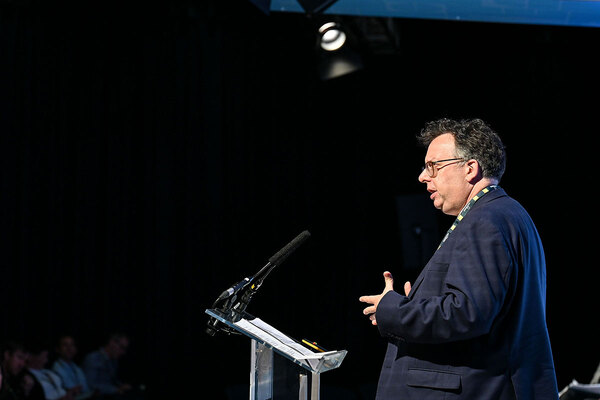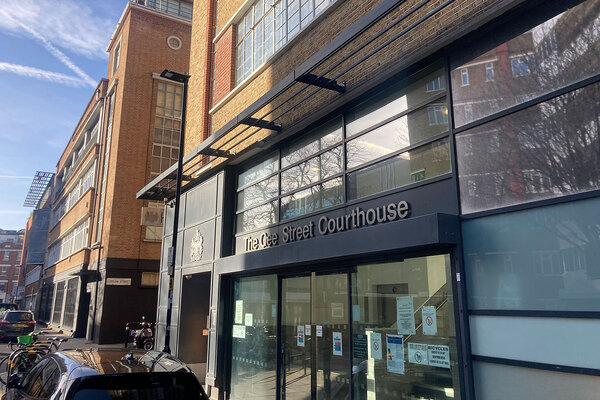Splash landing
Fifteen years ago Twilight Bey was flown in from America to keep LA-style gangs off London’s streets. He’s still at it today, hears Caroline Thorpe, helped by some innovative ideas on how to engage young people.
Twilight Bey doesn’t work in fashion. But he dresses with as much care as someone who does - particularly when it comes to headgear.
Today he is sporting a navy blue baseball cap embroidered with a single red ‘B’, for Baltimore. It seems a surprising choice for a man born in Texas, raised for the most part in Los Angeles and now a youth leader for a London housing association. But he has his reasons.
Some of the young people in the west London communities he works in are very particular about their attire - blue in Brent, red in Ladbroke Grove. And in an area where talk of territorial - or ‘postcode’ - conflicts is common, Mr Bey doesn’t want anyone thinking he’s taking sides.
‘I blend the colours up,’ the 39-year old explains, detailing a cap collection with a palette as varied as the graffiti pit he’s showing off. The four walls of the sunken basketball court have been given over to the street artists of the surrounding estates. Mr Bey squints at a particularly elaborate - and apparently indecipherable - tag. ‘It’s like calligraphy. But it [always] says something,’ he assures.
Mr Bey understands more than most the complexities of urban living. Five years ago Kensington Housing Trust, part of Catalyst Housing Group, employed him to run its youth engagement team. Concerns over anti-social behaviour were mounting along with the level of crime among the young people living in the 2,500-home landlord’s communities. Mr Bey took on the task of engaging the areas’ ‘hard to reach’ youth - and making residents feel safer in the process.
Starting out
Building on his own experiences growing up in gang-addled South Central LA and subsequently developing youth engagement projects there, Mr Bey started ‘Pathways 2 Progress’: a sophisticated development programme offering tailored support to young people at risk of committing crime and anti-social behaviour, and those known to the police.
If local youth clubs had excluded them, or they’d just left jail, P2P was for them. ‘If we’re not able to get them to see the light, then they’re probably not going to see it,’ is Mr Bey’s take.
Certainly the P2P approach to youth engagement is unusual. Mr Bey favours working intensively with small groups of young people for long periods over high-volume, short term activities - an Easter holiday go-karting trip, for example - to keep kids occupied and resisting the lure of misbehaviour or, worse still, gangs. It seems to work. On Mr Bey’s watch youth crime has fallen and positive outcomes have gone up. Other associations and councils are paying Catalyst to run the P2P model for them. And the young people and their parents are fans. So what’s the secret?
You’d be hard pressed to find a carbon copy of Mr Bey himself. Ask around and the words used to describe him glow: ‘charismatic’, ‘inspirational’, ‘able to bring a different dimension’. His Swahili name alone - evoking some dreamy Caribbean isle - marks him out.
Indeed it was a prophetic choice for a man who has devoted his professional life to youth work. ‘The word Twilight itself is the time between night and day. So it’s been described as a place where [my family] saw me,’ he explains, his accent caught similarly between two cultures: west coast drawl punctuated by crisply enunciated British ‘ts’.
‘It’s not being in the dark with my peers, but slightly brighter than my peers; but not able to walk in the light with my elders, because I hadn’t earned my stripes to be there yet.’ The chance to do so came earlier for Mr Bey than most. The eldest of five children, it fell to him to head the household when his parents’ marriage broke down and his mother moved her young family from Texas to Los Angeles in the late 1970s. He looked out for his siblings, helped with the chores and made sure the home was secure.
‘I grew up in a gang-affected community,’ Mr Bey says simply. ‘A neighbourhood plagued by crime, plagued by social economic deprivation, worklessness.’ The kind of neighbourhood, in fact, that UK Home Secretary Alan Johnson had in mind last week in a speech which rallied: ‘We need to do more to tackle gang violence, to further reduce shootings and stabbings, and more, much more, to address the problems of anti-social behaviour.’
Talking the talk
In part it’s Mr Bey’s background that lends him currency with the young people he seeks to help through P2P - currently around 100 12 to 21-year-olds. He understands how deprivation can stifle potential and is living proof that it can be fulfilled. Mr Bey won’t admit to having been in a gang - US law prohibits membership. ‘I still have a US passport,’ he points out, though he has spent much of the last 16 years in the UK, the last six living in London with his wife and their two children.
‘People never admit to being in a gang,’ he continues. ‘But if you’re in a [gang-dominated] environment, you’re never completely disconnected from it… Even if you’re not a gang member, rivals don’t see you in that way.’
Back in LA, the Bey family’s religious values and abhorrence of violence provided a moral barrier against much of what went on around him - to a point. ‘I defended myself when challenged,’ he admits. But resistance was tough. Gangs represented ‘fraternities’ for unemployed young men like Mr Bey seeking structure and belonging, and when crack cocaine flooded the LA streets in the early 1980s, the allure was strong.
He says he didn’t deal drugs himself, but understands why others did. ‘When it first came in it seemed like it was OK… Everybody just knew that [selling] it allowed them to have the opportunity to eat something nice or buy some new clothes.’
When he was 18 a chance encounter between his brother and a community worker saw Mr Bey recruited to mediate between infamous South Central gang rivals the Bloods and the Cripps. ‘Among my peers in that capacity there was some level of influence,’ he says modestly. A career in youth engagement was born.
In 1994 that career brought him across the Atlantic. A south London community group invited a 24-year old Mr Bey ‘to see if London was ripe, for lack of a better description, for an LA-style gang culture’.
During his three-month stay he discovered communities far removed from the streets of his youth, but warned that a similar culture could develop if concerns over social mobility and opportunity for deprived neighbourhoods weren’t addressed.
He was most worried by what he found in Manchester, then being dubbed ‘Gunchester’. Tackling these concerns brought Mr Bey back to the UK frequently in the following years to ‘share what it was that I and my peers had developed in the States’. Eventually - married to a Brit and with no plans to return to the States - he found his current role at KHT.
Most of his time is spent running P2P. One-to-one weekly support with a mentor, drop in sessions, extra curricular activities, away days, residential courses, training and work experience aim to equip participants to function in society and the workplace.
Getting them along in the first place is part of the challenge - and one which many housing providers are struggling to overcome. Mr Bey’s solution begins with training housing officers to look out for ‘what we call ASB pre-indicators’.
‘If you have a single parent family and the parent works evenings and they have adolescent children, you know there’s a chance that there may be some ASB there,’ he gives by way of example. ‘We target situations like that.’
Mr Bey and his supported housing officer staff will encourage these young people to come along to a Friday night drop-in session. Sometimes teenagers simply come along with friends, to see if it’s for them. Then it’s time for the youngsters to talk - and Mr Bey’s lot to listen. The process of ‘reaching’ the hard to reach is underway.
In sessions he dubs ‘real talk’ Mr Bey says: ‘We ask young people how they feel. We give them opportunity to tell us why they’ve used the terms they’ve used to describe how they feel.’
Once a month there’s a ‘making it happen’ session. ‘[It’s] about taking one of the things young people always identify as an obstacle to them achieving success,’ explains Mr Bey. ‘And then they come up to us, and they initially say “well what can I do to make this happen?” And we say, “OK, you’re ready for a mentor”.’
Mr Bey explains his tactics: ‘This generation is the broadband generation. They don’t really understand that the world works on dialogue - things work a lot slower than you might believe them to… I say you guys want [success] - but you don’t realise there’s a process to go through to get it. It’s about reintroducing that kind of thought process to young people, but at the same time giving them challenges and things to do to develop their understanding.’
The programme isn’t cheap: it costs around £1,500 to put a young person through P2P. But Mr Bey is able to reel off a rich seam of success stories.
Positive outcomes
Two of the first P2P youths came to the programme from jail. Now one of them works for a construction firm, the other has a job in Essex. Others have finished school, gone to university, entered management.
Luke Angol, an 18-year-old who signed up to P2P after finding a drop-in session ‘kinda interesting’ plans to go to art school after taking A levels next year. ‘If it wasn’t for a positive role model like Twilight a lot of negative things would be happening on the roads,’ he says. ‘Everyone has been affected by Twlight.’
In his understated way, Mr Bey agrees. ‘I just think back to some of the things that were going on in their lives at the time [they came to us]. If we hadn’t been there, I think the outcomes would have been different.’
The numbers are also doing some talking. On one west London estate where P2P operates, 2008/09 saw youth arrests drop by 17 per cent, from 81 to 67, on the previous year, which police have largely credited to scheme.
As P2P extends its reach - Catalyst provides the service for Hammersmith and Fulham Council’s arm’s-length management organisation and youth outreach programmes for two other London councils - Mr Bey urges others to do more. ‘I’ve worked in probation, I’ve worked in the prison service, I’ve worked in schools. And one of the reasons I believe social landlords are well-paced [for youth engagement] is that they have the ability to make investments in the way that others are not necessarily able to… Housing associations are able to leverage their spending with contractors and other key service providers.’
When landlords negotiate these ‘multimillion pound contracts’, they should be asking for added value. ‘We want our young people trained. We want our young people given opportunities to do these things. And that in itself leads to one of the key outcomes of our model, which is economic wellbeing.’
He fears the recession will see the nation’s dispossessed youth fall victim to spending cuts. That, he warns, could finally bring the LA-style gangs of his own youth to the UK - and the day when the colour of this hat is the least of his worries. ‘Things are starting to pretty much bubble under the surface,’ he indicates. ‘But I would say that London is still in a great, great position to nip the situation in the bud.’
If, of course, investment in projects like his own continues. ‘It’s a benefit to the tenants. It’s a benefit they can see and feel,’ he urges. ‘Because as [social landlords] improve life for young people, they improve the quality of life for everyone.’
Down with the kids
The Twilight guide to engaging ‘hard to reach’ youth
- Go out and actually engage with young people
- Create a safe space and say ‘this is for you’
- Be consistent - deliver on your promises, and fast







